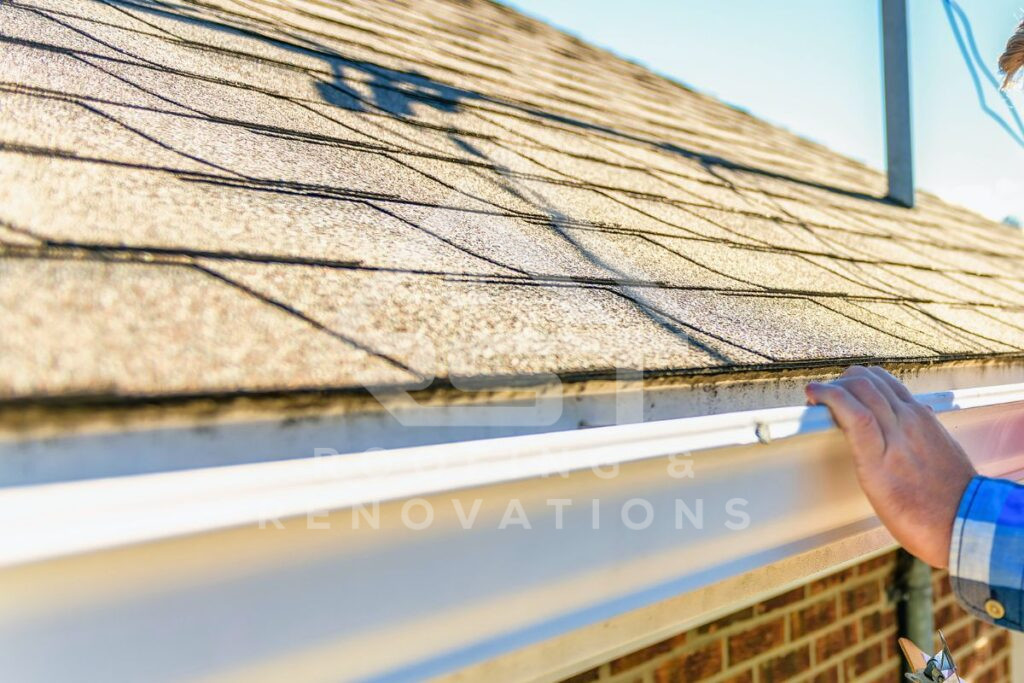The brittle test on shingles is an easy way to identify if your roof is in good condition. As a homeowner, if you are unsure about the existing condition of your roof shingles, you can get answers through the shingle brittle test. This simple roof shingle test can help you determine whether your roof needs repairs or a complete replacement.
As a homeowner or professional, understanding how to properly conduct and interpret a brittle test can save you time, money, and future headaches. In this complete guide, we will discuss how to perform a brittle test on shingles effectively.
What Is a Shingle Brittle Test?

Before starting the process, it is important to know what this test is. The roof shingle brittle test is a field technique used to evaluate whether your shingles can be safely repaired.
Basically, it is a flexibility check for your roof’s materials. When performing a brittle test on shingles, you’re essentially assessing whether the shingles can be lifted and manipulated without breaking or cracking.
This is an important factor in determining if individual shingle replacement is possible or if you’re looking at a more extensive roof replacement project.
The primary goal of brittleness testing is to simulate the conditions that would occur during a repair. When roofers replace damaged shingles, they need to lift surrounding shingles to access and remove fasteners. If these surrounding shingles are too brittle, what started as a simple repair could turn into a much bigger project due to additional damage caused during the repair attempt.
Important Things to Know Before Testing
Before you start any brittle test, there are certain things that you need to consider to ensure accurate results and prevent unnecessary damage:
#1 Temperature Considerations
Your brittle test should only be performed when the outdoor temperature is 45 degrees or warmer. This isn’t just a suggestion, it’s a requirement because temperature significantly affects shingle flexibility.
Cold temperatures naturally make shingles more rigid and brittle, which can lead to false test results and potentially unnecessary roof replacements.
If you must inspect during colder weather, consider waiting until the afternoon when temperatures are typically warmer.
#2 Location Selection
Only perform your roof shingle brittle test on areas that already show damage. Testing undamaged sections can void warranties and create new problems where none existed before.
Document the specific areas you plan to test with photographs before beginning.
#3 Documentation Requirements
Take detailed photos before, during, and after your brittle test. Record the temperature and weather conditions at the time of testing.
Make notes about the age of the roof and any visible existing damage. Keep all documentation organized in case you need to file an insurance claim.
How to Perform a Proper Brittle Test
Now comes the main section of today’s topic. To perform a safe and effective brittle test on shingles, follow these steps:
#1 Preparation Phase
The first and foremost step is preparation. Start by checking the weather conditions and make sure the temperature is above 45 degrees. Gather all the necessary tools that you will need throughout the test.
Materials Required!
👉 Putty knife or flat bar for breaking seals.
👉 Clean gloves to protect both your hands and the shingles.
👉 Camera for documentation.
👉 Roofing cement for resealing if needed.
👉 Notepad for recording observations.
After gathering all the important tools and materials, take comprehensive pre-test photos from multiple angles. Also, make sure you have stable and safe access to the test area.
#2 Break the Seal Between the Shingles
Use your putty knife and gently break the adhesive seal between shingles. Make sure that you work slowly and methodically to prevent tearing. Begin with the edge and work your way in. Remember to pay special attention to how much resistance you encounter, this can indicate the overall condition of your shingles.
#3 The Testing Process
Now begin with the main brittle test on the shingles. For that, lift your roof shingle gently to a 45-degree angle. Please maintain steady and even pressure, and avoid jerking or sudden movements.
It is recommended to watch for any immediate signs of stress or damage. Make sure you pay attention to how the shingle feels as you lift it. Also notice the amount of granule loss, if any, during the process.
#4 Assess The Results
Look for these specific problems that directly indicate your roof shingles are brittle:
👉 Cracks or tears in the shingle
👉 Creases that remain after laying the shingle back down
👉 Granule loss patterns
👉 The overall flexibility of the material
Document all observations with detailed photos and notes.
How To Know If Your Shingles Have Passed Or Failed The Brittle Test?
After completing your brittle test, you’ll need to interpret what you’ve observed. Here’s a detailed breakdown of what different results might indicate:
Signs That Your Shingles Have Failed The Brittle Test
🛑 Immediate cracking or breaking when lifted
🛑 Visible stress lines or creases that don’t disappear
🛑 Excessive granule loss during manipulation
🛑 Audible cracking or popping sounds during testing
🛑 Shingle remains bent or deformed after being laid back down
🛑 Breaking or tearing around nail holes
Signs That Your Shingles Have Passed The Brittle Test
✅ Shingle returns to its original position without damage
✅ Maintains flexibility throughout the lifting process
✅ No visible stress marks or creases
✅ Minimal to no granule loss during manipulation
✅ Edges remain intact and uniform
✅ No separation of layers (for laminated shingles)
Common Misconceptions About Brittle Testing On Roof Shingles
There are common misconceptions about the brittle test on roof shingles. Here’s a quick overview of them.
#1 Industry Standards
The first misconception homeowners generally make is that the roof shingle brittle test is a standardized industry test.
Despite its widespread use, the brittle test isn’t an officially standardized industry test. No governing body has established universal testing procedures, and the results can vary based on who performs the test and what method is used.
So consider it a simple assessment for your roof shingles.
#2 Temperature Effects
Many believe any temperature above freezing is acceptable for testing and that morning testing is the same as afternoon testing.
But it is important to remember that the results can vary significantly based on sun exposure and shade. Another important thing to keep in mind is that the surface temperature matters just as much as the air temperature.
When Is It Recommended To Skip The Brittle Test On Your Roof Shingles?
There are several situations where performing a brittle test might do more harm than good. Below is a quick overview of these scenarios.
#1 Weather Conditions
As we mentioned, the test is not effective during extremely cold weather (below 45 degrees), in wet conditions, or immediately after rain. Plus, intense heat might soften shingles too much, making roof access unsafe.
#2 Roof Conditions
If the roof is clearly damaged beyond repair and needs to be replaced, a brittle test is not necessary. This also applies to historic buildings or roofs made with specialty materials that require particular care and expertise.
Additionally, if your insurance company has already reviewed and approved a full replacement, you’re generally good to proceed with getting a new roof installed, so there’s no need to perform a brittle test on the shingles.
Is It A Good Idea To Call Professionals For Your Roofing Needs?
Yes, of course! While the shingle brittle test is an important tool in roof assessment, it shouldn’t be your only consideration.
Remember that your roof is a complex system, and decisions about repair or replacement should take into account multiple factors.
When in doubt, always consult with qualified professionals who can provide comprehensive evaluations and recommendations based on your specific situation.
Schedule Your Free Professional Roof Inspection In Georgia
A thorough roof inspection from professionals can help you make informed decisions for your roof.
At RST Roofing and Renovations, LLC, we are your local roofers in Atlanta. Our experienced team provides comprehensive inspections that identify potential issues before they become costly problems.
We take pride in providing detailed reports and honest recommendations to protect your investment.
We offer professional roofing services throughout Atlanta and the surrounding areas in Georgia. To schedule your roof’s free inspection or for a no-pressure discussion about your roof with our professionals, feel free to call us at (404) 548-8901.





